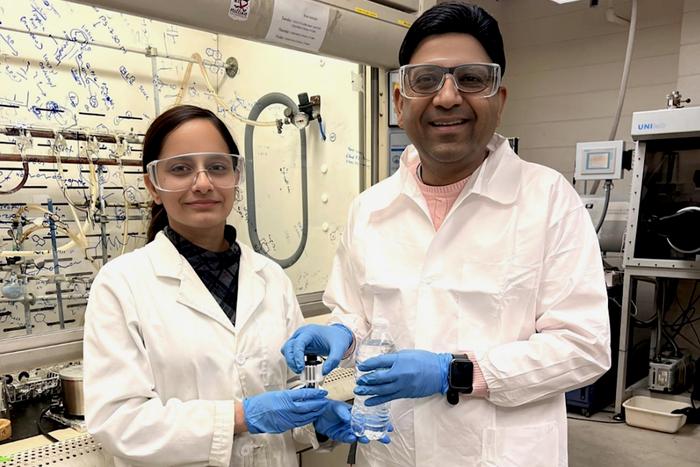University of Missouri researchers, led by Associate Professor Sachin Handa and graduate student Karanjeet Kaur, have unveiled a groundbreaking chemical tool that leverages a combination of engineered micellar water and electrical energy. This newly devised electrochemical technique shows significant promise for reducing both the financial costs and environmental toll involved in synthesizing crucial medicines. At its core, this innovative method aims to address the pressing issue of pre- and polyfluoroalkyl substances (PFAS), notorious for being resistant to degradation and frequently dubbed “forever chemicals,” which persist in the environment and pose serious health risks.
In sharp contrast to conventional electrochemical practices that employ toxic solvents and electrolytes, this novel research pushes the boundaries of safe and sustainable chemistry. By collaborating with Novartis Pharmaceuticals, the team has developed micelles—nano-sized molecular structures designed from natural amino acids and coconut oil. Their amphiphilic nature—characterized by having both hydrophilic (water-attracting) and hydrophobic (water-repelling) components—enables these micelles to mediate electrochemical reactions efficiently and safely.
The traditional laboratory processes typically involve a range of hazardous materials that contribute to environmental pollution. Handa, who is part of the College of Arts and Science at the University of Missouri, emphasizes the significance of micelles in their ability not only to drive chemical reactions forward but also to stay chemically inert themselves. This stability distinguishes them from their ionic counterparts, which tend to respond with other substances and complicate the chemical process. The researchers have identified that these micelles function optimally as a unified tool, reducing the need for additional solvents, electrolytes, and reaction enhancers.
The inception of micellar electrochemistry arose from a quest to utilize micellar solutions effectively with electrical input as a greener alternative for facilitating chemical reactions. Handa and Kaur’s research journey propelled them toward understanding how these novel micelles could act as conduits for promoting desirable chemical transformations without the inherent risks attached to conventional materials. One standout application of this method is its potential impact on developing antiviral medications targeting specific proteins related to health challenges such as the Hepatitis C virus.
Handa highlights the dual functionality of their micellar technique, which plays a crucial role not only in the synthesis of pharmaceuticals but also in addressing wider environmental concerns. In this context, electrocatalysis emerges as a vital process for producing clean energy, revealing the interconnectedness of chemistry, medicine, and environmental stewardship. The generation of hydrogen from this method offers a forward-thinking avenue that aligns with global initiatives aimed at transitioning towards a more sustainable energy future.
Moreover, the implications of Handa and Kaur’s research extend into multiple domains, suggesting enhancements in tackling inflammatory, immunoregulatory diseases, and supporting sustainable practices in pharmaceutical development. Integrating such innovative methodologies into the fabric of scientific research underscores the necessity for continued investment in safer, green technologies that can address contemporary challenges.
Their findings have been documented in a publication titled “Electrocatalytic Micelle-Driven Hydrodefluorination for Accessing Unprotected Monofluorinated Indoles,” featured in the prestigious journal Angewandte Chemie. This collaborative venture includes contributions from Raki Mandal and Justin Walensky at the University of Missouri, alongside Fabrice Gallou from Novartis Pharmaceuticals, which signifies the promising potential for interdisciplinary approaches to scientific inquiry.
The synergy behind this research represents a fundamental shift toward eco-friendliness in chemical processes, reinforcing the belief that innovation can coexist with environmentally responsible practices. As the scientific community looks towards advancements that prioritize the health of our planet while fostering human well-being, the work of Handa and Kaur stands as a testament to the power of innovative research and collaboration in resolving pressing global issues.
Through embracing alternative solutions that minimize traditional chemical hazards, researchers can pave the way for safer methodologies that contribute positively to health outcomes and environmental sustainability. The pioneering spirit that drives this research not only reflects individual accomplishments but also resonates with a larger movement aimed at sustainable scientific advancements.
As researchers continue to explore the full scope of micellar electrochemistry, the significance of this advancement cannot be overstated. This technique promises not just to redefine norms within the pharmaceutical industry but also to bring forth transformative changes in advanced materials, clean energy production, and environmental remediation efforts—a comprehensive approach that tackles today’s multifaceted challenges in chemistry and environmental science.
Subject of Research: Eco-friendly micellar electrochemistry
Article Title: Electrocatalytic Micelle-Driven Hydrodefluorination for Accessing Unprotected Monofluorinated Indoles
News Publication Date: 4-Jan-2025
Web References: DOI Article Link
References: Angewandte Chemie
Image Credits: Photo courtesy Sachin Handa
Keywords
Electrochemistry, Sustainable energy, Pharmaceuticals, Environmental chemistry, Micelles, Clean energy, Electrocatalysis, Toxic solvents, Medicinal chemistry, Hydrogen production, PFAS remediation, Green chemistry.
Tags: amphiphilic micellescollaboration with Novartis Pharmaceuticalselectrochemical techniquesengineered micellar waterenvironmental impact of chemical synthesisgraduate student research contributionsinnovative medicine cost reductionMizzou researchersnano-sized molecular structuresPFAS degradation methodssafe and sustainable chemistrysustainable energy solutions





